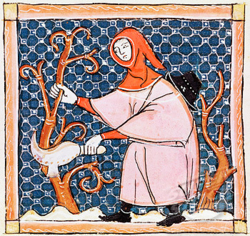The billhook has been used in England, and throughout most of Europe, for over two thousand years. Tools dating from the Roman
occupation of Britain have been found on sites in Wiltshire, Somerset and Essex. These
are very similar in shape to those still in use today, and are believed to have been used for similar purposes.
The billhook is mainly used for cutting and splitting green wood obtained from saplings, usually grown in coppices. The most commonly
used woods are hazel, willow, ash and chestnut; all of which split easily when green and can be easily bent by hand into shape. When allowed to dry in use the article made will often have an expected
working life in excess of ten years.
Typical woodland, or coppice, crafts which use the billhook, in gathering, cutting to size, splitting or trimming the sapling,
are: Hurdle making, Spar making ( spars or 'broches' are used for holding down thatch ), Besom broom making and Basket making. The tool was also widely used for cutting the faggots burned in
bread ovens, and in hedge laying. Here the living wood is trimmed and then partially cut through and bent, or laid, parallel, or at a low angle, to the ground where it will reshoot, providing a
renewable stockproof fence. This is still widely carried out in the middle of England, and also in parts of Wales. They were also often used for tree pruning, especially the removal of small side branches.
The large variety of shapes and types of billhook are believed to reflect the needs of the
individual villages of agricultural England prior to the Industrial Revolution. Originally, tools would have been made by the local blacksmith for use in a small locality. Later, small edge tool
works were set up, e.g. on the edges of Dartmoor and the Mendips, where first hand and later water powered forges produced tools for a wider area. Post 1800, larger industrial centres competed with
the smaller manufacturers, but in order to attract the trade they had to produce a wide range of regional varieties. Some of the Sheffield trade catalogues of the Victorian era show over 120 regional
variations, often obtainable in a range of sizes from 6" to 12" in length.
Many millions of billhook have been made, and as recently as the 1960's manufacturers offered a range of 20 to 50 different shapes.
Today, there are only a few makers left, and the range is more limited. However, with an increase in traditional craft activity, and with conservation use, the billhook is showing signs of
becoming more popular. At one time every household in rural England would possess at least one, and many were used in cities for splitting kindling wood. They are still commonly available and widely
used in the rural areas of Europe.
The collection, A Load of Old Billhooks, was started in the early 1980's with the intent of preserving a part of our rural and
industrial heritage that was fast disappearing. The collection is privately owned and currently has a total of several thousand tools, including over six thousand billhooks. Examples of most of
the regional styles can be seen and most English manufacturers are represented. However, there is still much research to be carried out and new finds are being made every week. Additions to the
collection are gratefully received and will be are fully restored and preserved for the enjoyment of future generations.

